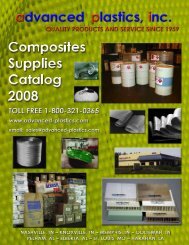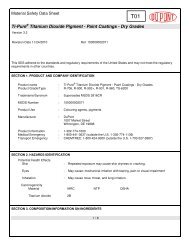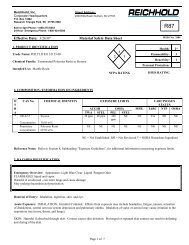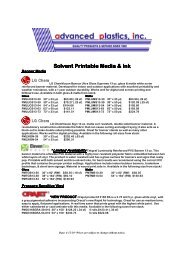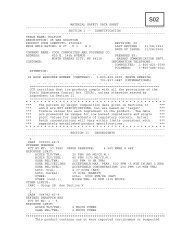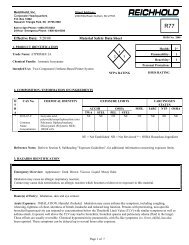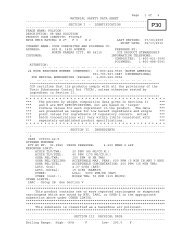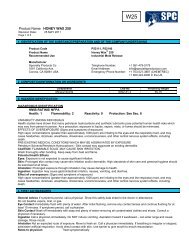F48 - Advanced Plastics
F48 - Advanced Plastics
F48 - Advanced Plastics
You also want an ePaper? Increase the reach of your titles
YUMPU automatically turns print PDFs into web optimized ePapers that Google loves.
Material Safety Data SheetStone Tex Series MSDS No. 9628.6Date of Preparation: 7/16/96 Revision: 11/7/08Section 1 - Chemical Product and Company IdentificationProduct/Chemical Name: Stone Tex SeriesGeneral Use: Granite Effect FillerManufacturer: The R. J. Marshall Company Emergency Phone: (800) 424-930026776 W. 12 Mile Road Date Revised: 11/7/08Southfield, MI 48034-7807Preparer: Stephanie NicholsSection 2 - Composition / Information on IngredientsIngredient Name CAS NumberCalcium Carbonate 1317-65-3Crystalline Silica 14808-60-7Filled Polyester ------------------Trace Impurities:OSHA PELACGIH TLVIngredient TWA STEL TWA STELCalcium Carbonate15 mg/m 3 total dust none estab. 10 mg/m 3 none estab.5mg/m 3 respirable dustCrystalline Silica 10mg/m 3 respirable dust none estab. .025 mg/m 3 respirable dust none estab.Section 3 - Hazards Identification Emergency Overview Potential Health EffectsPrimary Entry Routes: Inhalation, Eye, and Ingestion.Acute EffectsInhalation: Inhalation of high concentrations of this inert nuisance particulate can result in mild irritation of the respiratorytract.Eye: May cause irritation through mechanical abrasion.Skin: May cause irritation through mechanical abrasion.Ingestion: Unlikely.Carcinogenicity: IARC has listed crystalline silica as a human carcinogen.Chronic Effects: This product contains crystalline silica as an impurity. Prolonged exposure to respirable crystalline silica dustconcentrations exceeding occupational exposure limits without the use of the proper respirator may increase the risk ofdeveloping a disabling lung disease called silicosis. OSHA, NTP, or IARC does, not list this product itself, Stone Tex, as acarcinogen.Section 4 - First Aid MeasuresHMIS100Inhalation: If overcome by high dust concentrations, remove to a ventilated area.Eye Contact: Flush eyes thoroughly for 15 minutes taking care to rinse under eyelids. Do not scrub. Abrasion may causeirritation. If discomfort continues, continue to wash with water. If irritation persists, consult a physician.Skin Contact: Wash skin thoroughly with soap and water for at least 15 minutes. Consult a physician if irritation persists.Ingestion: Ingestion of very large quantities may result in intestinal obstruction and/or constipation. Considered to be of verylow toxicity.After first aid, get appropriate in-plant, paramedic, or community medical support.Note to Physicians: n/aSpecial Precautions/Procedures: n/aHFRPPE † E† Sec. 8Section 5 - Fire-Fighting Measures
evision date 11/7/08 Stone Tex Series MSDS No. 9628.6Flash Point: None known.Flash Point Method: n/aBurning Rate: Not determined.Autoignition Temperature: not determined.Flammability Classification: Non-flammableExtinguishing Media: Water spray, carbon dioxide, or other dry chemical.Unusual Fire or Explosion Hazards: None known.Hazardous Combustion Products: None.Fire-Fighting Instructions: Do not release runoff from fire control methods to sewers or waterways.Fire-Fighting Equipment: Because fire may produce toxic thermal decomposition products, wear a self-contained breathingapparatus (SCBA) with a full facepiece operated in pressure-demand or positive-pressure mode.Section 6 - Accidental Release MeasuresSpill /Leak Procedures: Collect solids. Recycle if possible.Regulatory Requirements: Follow applicable OSHA regulations (29 CFR 1910.120).Handling Precautions: Avoid generating dust during handling.Storage Requirements: Keep material dry.Section 7 - Handling and StorageSection 8 - Exposure Controls / Personal ProtectionEngineering Controls:Ventilation: Provide general or local exhaust ventilation systems to maintain airborne concentrations below OSHA PELs(Sec. 2). Local exhaust ventilation is preferred because it prevents contaminant dispersion into the work area by controlling it atits source.Administrative Controls:Respiratory Protection: Seek professional advice prior to respirator selection and use. Follow OSHA respirator regulations(29 CFR 1910.134) and, if necessary, wear an MSHA/NIOSH-approved respirator. Select respirator based on its suitability toprovide adequate worker protection for given working conditions, level of airborne contamination, and presence of sufficientoxygen. For emergency or nonroutine operations (cleaning spills, reactor vessels, or storage tanks), wear an SCBA.Warning! Air-purifying respirators do not protect workers in oxygen-deficient atmospheres. If respirators are used, OSHArequires a written respiratory protection program that includes at least: medical certification, training, fit-testing, periodicenvironmental monitoring, maintenance, inspection, cleaning, and convenient, sanitary storage areas.Protective Clothing/Equipment: Wear chemically protective gloves, boots, aprons, and gauntlets to prevent prolonged orrepeated skin contact. Wear protective eyeglasses or chemical safety goggles, per OSHA eye- and face-protection regulations(29 CFR 1910.133). Contact lenses are not eye protective devices. Appropriate eye protection must be worn instead of, or inconjunction with contact lenses.Safety Stations: Make emergency eyewash stations, safety/quick-drench showers, and washing facilities available in work area.Contaminated Equipment: Separate contaminated work clothes from street clothes. Launder before reuse. Remove thismaterial from your shoes and clean personal protective equipment.Comments: Never eat, drink, or smoke in work areas. Practice good personal hygiene after using this material, especially beforeeating, drinking, smoking, using the toilet, or applying cosmetics.Physical State: PowderAppearance and Odor: Various color, odorlessOdor Threshold: n/eVapor Pressure: n/eVapor Density (Air=1): n/aFormula Weight: n/aDensity: n/eSpecific Gravity (H 2 O=1, at 4 °C): 2.7pH: 9-10Section 9 - Physical and Chemical PropertiesWater Solubility: slightOther Solubilities: n/aBoiling Point: n/aFreezing/Melting Point: n/aViscosity: n/aRefractive Index: n/aSurface Tension: n/a% Volatile: n/aEvaporation Rate: n/aPage 2 of 4
evision date 11/7/08 Stone Tex Series MSDS No. 9628.6Section 10 - Stability and ReactivityStability: This product is stable at room temperature in closed containers under normal storage and handling conditions.Polymerization: Hazardous polymerization cannot occur.Chemical Incompatibilities: Calcium carbonate will react with strong acids to form carbon dioxide.Conditions to Avoid: None known.Hazardous Decomposition Products: n/aEye Effects: Nuisance dust. May causeirritation through mechanical abrasion. Flushwith water for at least 15 minutes. Consultphysician if irritation is persistent.Section 11- Toxicological InformationToxicity Data: *Acute Inhalation Effects: Nuisance dust. Overexposure to dust maycause irritation of the respiratory tract, remove affected individual tofresh air. If symptoms persist, consult a physician.Skin Effects: Nuisance dust. May causeirritation through mechanical abrasion. Washskin thoroughly with soap and water.Acute Oral Effects: None known.Chronic Effects: None known.Carcinogenicity: Crystalline silica is listed as a human carcinogen.No information available.Section 12 - Ecological InformationSection 13 - Disposal ConsiderationsDisposal: Recycle if possible or landfill. This substance is inert and does not require special disposal methods. Followapplicable Federal, state, and local regulations.Section 14 - Transport InformationDOT Transportation Data (49 CFR 172.101): This product is not classified as dangerous under the transport regulations forroad, rail, sea, or air transport.Section 15 - Regulatory InformationEPA Regulations:RCRA Hazardous Waste Number: Not listed (40 CFR 261.33)RCRA Hazardous Waste Classification: Not classifiedCERCLA Hazardous Substance (40 CFR 302.4) not listedSARA Toxic Chemical (40 CFR 372.65): Not listedSARA EHS (Extremely Hazardous Substance) (40 CFR 355): Not listedCrystalline Silica is subject to the reporting requirements of California’s Safe Drinking Water and Toxic Enforcement Act of1986 (“Proposition 65”).OSHA Regulations:Air Contaminant (29 CFR 1910.1000, Table Z-1, Z-1-A): Not listedTSCAThis substance or all of its components are on the Chemical Substances Inventory of the Toxic Substance Control Act (TSCAInventory [USA]). Please note that this product is not subject to any legal reporting requirements under these acts.INTERNATIONAL REGULATIONSCanadian Domestic Substances List: Components of this product are listed on the Canadian DSL.European Community: Components of this product are listed on ECOIN, the European Core Inventory (EC) market.Page 3 of 4
evision date 11/7/08 Stone Tex Series MSDS No. 9628.6Prepared By: Stephanie NicholsRevision Notes: 11/7/08Section 16 - Other InformationProduct Grades Available from the R. J. Marshall Company (this list may be incomplete):This MSDS covers all Stone Tex special blends and EXP ST blends.Disclaimer: Information contained herein is presented in good faith and is based on data believed to be accurate. However nowarranty is expressed or implied regarding this information or the results obtained from the use of this Material Safety DataSheet, whether it originates with The R. J. Marshall Company or others. This Material Safety Data Sheet relates only to thespecific material designated herein. It does not relate to use with other material or processes. This information is supplied withthe condition that the user will make appropriate determination as to its suitability for their purpose prior to using it.Page 4 of 4





